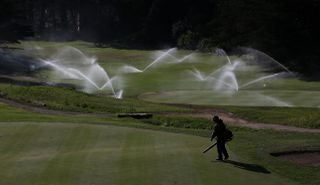Why You Should Cut Your Greenkeeper Some Slack
As Sustainable Golf Week continues, we speak to BIGGA Chief Executive Jim Croxton about issues of sustainability in greenkeeping including climate, resources and regulation.


On the second day of Sustainable Golf Week, hosted by the GEO Foundation for Sustainable Golf, the focus is on “Golf Courses of the Future.” As we look to find more sustainable ways to maintain our golf courses, methods and approaches within greenkeeping are altering. Expectations from golfers will also have to alter as greater control on water and chemicals mean playing surfaces are changing. We spoke to Jim Croxton, Chief Executive of the British and International Golf Greenkeepers Association (BIGGA) to find out more about sustainable golf course maintenance and the challenges faced by the modern greenkeeper.
Golf Courses of the Future

BIGGA has worked hard with The R&A in recent years on a project called “Golf Course 2030.” Its objective has been to answer the question, ‘How can we have the same playing surfaces that we use today with only 25% of the water usage, no chemicals and no fertilisers?’ BIGGA greenkeepers, scientists, the STRI and R&A agronomists have been working on the project. It has displayed the need to adapt the approach to golf course maintenance.
“In the last couple of years, challenges in the world, let alone our industry, have really intensified the need to act,” says Jim Croxton. “There are so many challenges with climate, with regulations and resources. Within those resources I now tend to throw labour as a finite resource in the same way that water and sand would be included.”
Restrictions on the use of fertilisers and on treatment for the likes of leatherjackets and chafer bugs that can damage turf condition have been a challenge for greens teams but perhaps the most significant problem to be faced now and in coming years is the shortage of water.
“Water usage is going to become a major problem and I think golfers are going to have to get used to golf courses that are different colours in different seasons,” says Jim Croxton. “We’re going to see times of water scarcity. Clubs are investing in their water resilience and that’s important – bore holes or even reservoirs.”
Rising Costs and Greenkeeping into the future

The rising cost of living affects everything, including golf courses. It now costs more to run machinery, to pay staff members, to pay for top dressing and so on.
“Clubs are understanding that you can’t just keep doing what they did,” says Jim Croxton. “Membership subscription rates are not going up in line with inflation so a reframing of the costs is required. If you want to maintain surfaces at a level, you’re probably going to have to pay more now, invest more labour.”
Get the Golf Monthly Newsletter
Subscribe to the Golf Monthly newsletter to stay up to date with all the latest tour news, equipment news, reviews, head-to-heads and buyer’s guides from our team of experienced experts.
Improving efficiency is a key to future greenkeeping and automation will be a part of that.
“It’s quite conceivable that the greenkeeping team of the future will be smaller but more highly skilled,” says Jim Croxton. “We know that automated mowing is coming. We’re seeing it in other sports and agriculture, and it works for the longer grasses on golf courses already. But that doesn’t mean we’ll have days when greenkeepers don’t turn up to work. What it does mean is they can turn their attention to turf health and presentation.”
Managing Expectations
One problem greenkeepers face is with raised expectations. Despite the fact costs are rising and golf course traffic has increased, the pressure to deliver can be overwhelming. But Jim Croxton thinks most golfers will understand the situation if the message is put to them correctly.
“Communication is the key. A lot of golfers do enjoy dry golf courses where the ball runs for miles, certainly on links and perhaps heathland courses. But perhaps we have to manage expectations in the parkland setting. We need to explain to golfers that this is part of the game and it’s part of the charm of the game,” he says. “There’s a view that golfers will not accept changes in condition. I don’t think that’s entirely true. If we explain that we’re going to continue to make the green surfaces as good as we possibly can, but that you may see a difference in visual quality of fairways or you may see longer grass in areas that are being rewilded, because of the costs or resources required to manage rough land areas, I think that makes sense to most people.”
Changing Wider Perceptions

Golf courses take up roughly 1% of England. That figure is seen as a disaster by certain people outside of the sport who believe golf courses are wall to wall pesticides, water and fertiliser. But actually, if you look at Google Maps of somewhere like Surrey, you’ll see the golf courses as corridors where the environment can flourish, certainly in the urban areas.
“We need to be on the front foot more,” says Jim Croxton. “At BIGGA we employ an in-house ecologist who provides great stories on how golf courses provide corridors for wildlife and biodiversity. In Scotland for instance, the reintroduction of small blue butterflies and orchids have been a huge success – We need to keep reminding people that golf is actually a good sport for the environment.”
Through Sustainable Golf Week, the focus will be on different aspects of sustainability within golf. Here’s the schedule going forward:
Tuesday 4th: Golf Courses of the Future
Wednesday 5th: Big and Visible – The Professional Game
Thursday 6th: Golf, Cities and Land
Friday 7th: Moving Day
Saturday 8th: Highlights of the Week
Sunday 9th: Driving Further
Visit Sustainable Golf Week and GEO Foundation to find out more.

Fergus is Golf Monthly's resident expert on the history of the game and has written extensively on that subject. He has also worked with Golf Monthly to produce a podcast series. Called 18 Majors: The Golf History Show it offers new and in-depth perspectives on some of the most important moments in golf's long history. You can find all the details about it here.
He is a golf obsessive and 1-handicapper. Growing up in the North East of Scotland, golf runs through his veins and his passion for the sport was bolstered during his time at St Andrews university studying history. He went on to earn a post graduate diploma from the London School of Journalism. Fergus has worked for Golf Monthly since 2004 and has written two books on the game; "Great Golf Debates" together with Jezz Ellwood of Golf Monthly and the history section of "The Ultimate Golf Book" together with Neil Tappin , also of Golf Monthly.
Fergus once shanked a ball from just over Granny Clark's Wynd on the 18th of the Old Course that struck the St Andrews Golf Club and rebounded into the Valley of Sin, from where he saved par. Who says there's no golfing god?
-
 The 7 Biggest Golf Gear Trends In 2025
The 7 Biggest Golf Gear Trends In 2025Take a look at the most popular golf equipment trends of 2025 and why your game may benefit from them
By Sam De'Ath Published
-
 Forget Amazon's Big Spring Sale, Garmin Has These 5 Excellent Deals Worth Your Attention
Forget Amazon's Big Spring Sale, Garmin Has These 5 Excellent Deals Worth Your AttentionAmazon isn't the only place for the best golf deals ahead of the new season...
By Conor Keenan Published